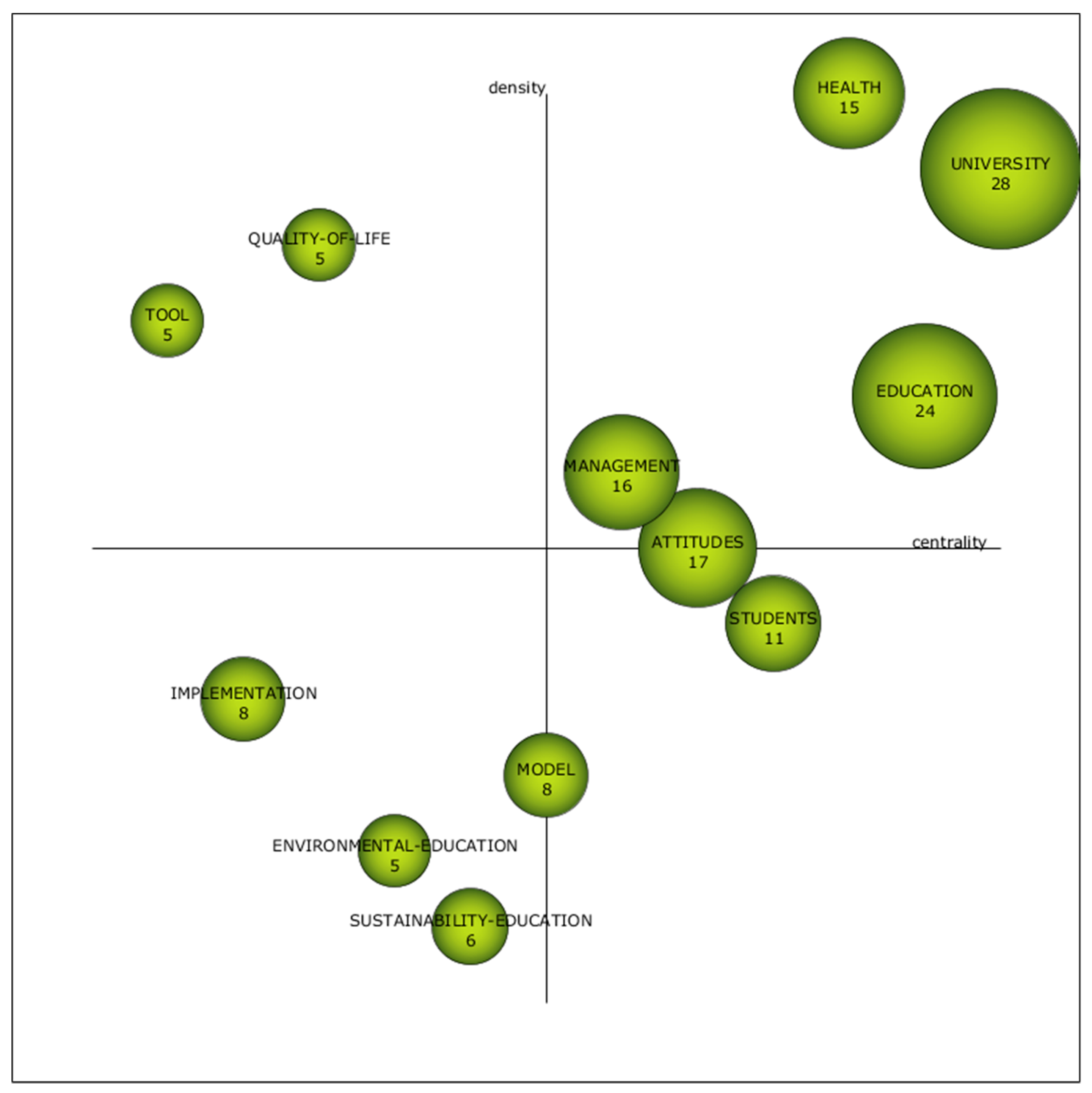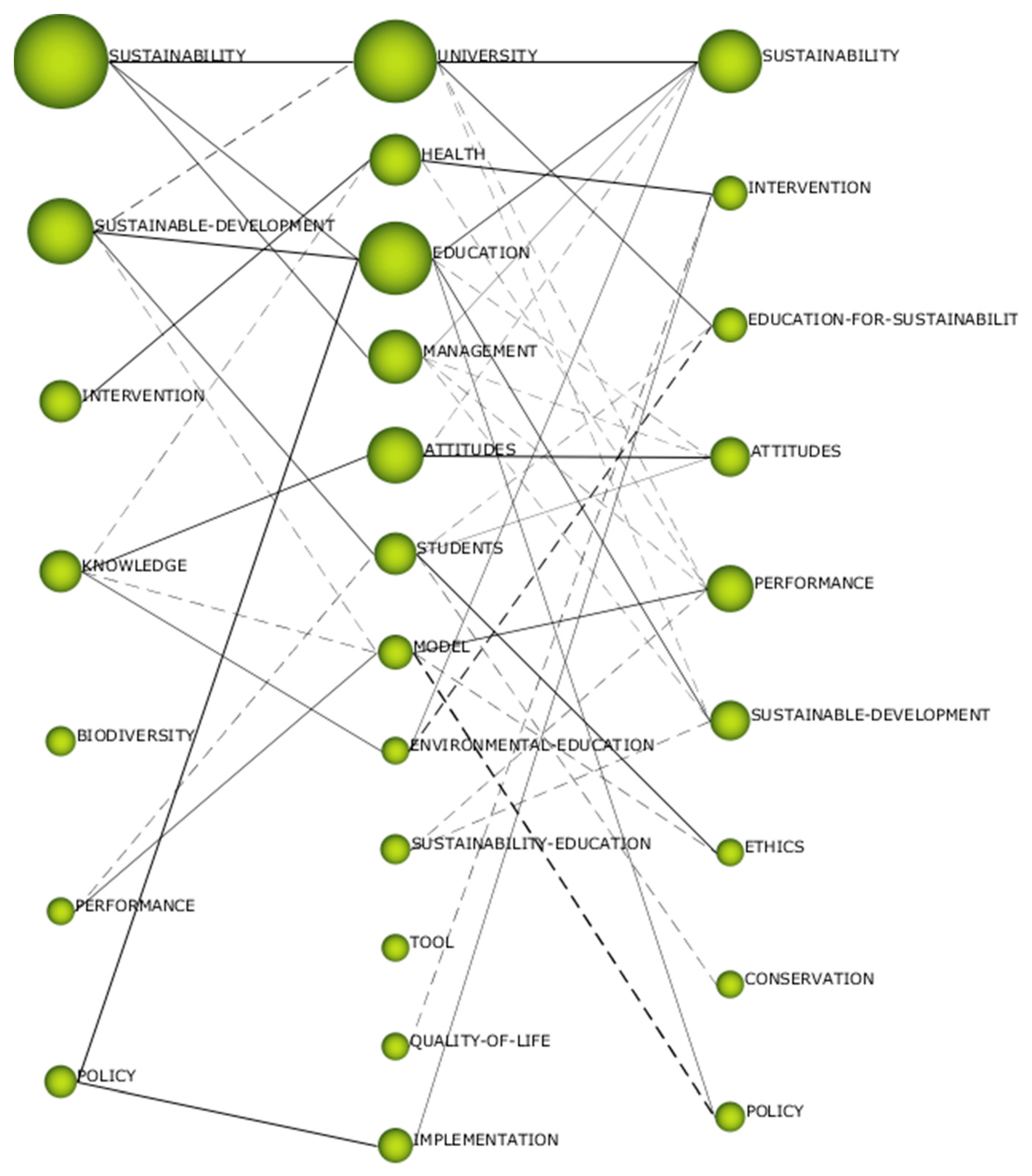Productive, Structural and Dynamic Study of the Concept of Sustainability in the Educational Field
Abstract
1. Introduction
2. Research Objectives
- To identify the scientific output and production of the terms “sustainability” and “education” in scientific texts.
- To know the scientific evolution of the concepts of sustainability and education.
- To determine the most relevant themes in the field of study on sustainability and education.
3. Materials and Methods
4. Results
4.1. Performance and Scientific Production
4.2. Structural and Thematic Development
5. Discussion
6. Conclusions
Author Contributions
Funding
Conflicts of Interest
References
- Aragon-Correa, J.A.; Marcus, A.A.; Rivera, J.E.; Kenworthy, A.L. Sustainability Management Teaching Resources and the Challenge of Balancing Planet, People, and Profits. AMLE 2017, 16, 469–483. [Google Scholar] [CrossRef]
- Bessant, S.E.F.; Robinson, Z.P.; Ormerod, R.M. Neoliberalism, new public management and the sustainable development agenda of higher education: History, contradictions and synergies. Environ. Educ. Res. 2015, 21, 417–432. [Google Scholar] [CrossRef]
- Feinstein, N.W.; Kirchgasler, K.L. Sustainability in Science Education? How the Next Generation Science Standards Approach Sustainability, and Why It Matters. Sci. Educ. 2015, 99, 121–144. [Google Scholar] [CrossRef]
- Wiek, A.; Withycombe, L.; Redman, C.L. Key competencies in sustainability: A reference framework for academic program development. Sustain. Sci. 2011, 6, 203–218. [Google Scholar] [CrossRef]
- Hedefalk, M.; Almqvist, J.; Ostman, L. Education for sustainable development in early childhood education: A review of the research literature. Environ. Educ. Res. 2015, 21, 975–990. [Google Scholar] [CrossRef]
- UNESCO. National Journeys, towards Education for Sustainable Development, United Nations Decade of Education for Sustainable Development 2005–2014; UNESCO: Paris, France, 2011. [Google Scholar]
- Calixto, P.S.; Hernández, M.A. La evolucion del concepto de sostenibilidad y su incidencia en la educacion ambiental. Teoría de la Educación 2008, 20, 179–207. [Google Scholar]
- Wals, A.E. Sustainability in higher education in the context of the UN DESD: A review of learning and institutionalization processes. J. Clean. Prod. 2014, 62, 8–15. [Google Scholar] [CrossRef]
- Aikens, K.; McKenzie, M.; Vaughter, P. Environmental and sustainability education policy research: A systematic review of methodological and thematic trends. Environ. Educ. Res. 2016, 22, 333–359. [Google Scholar] [CrossRef]
- Cheeseman, A.; Wright, T.S.A.; Murray, J.; McKenzie, M. Taking stock of sustainability in higher education: A review of the policy literature. Environ. Educ. Res. 2019, 1–16. [Google Scholar] [CrossRef]
- Christie, B.A.; Miller, K.K.; Cooke, R.; White, J.G. Environmental sustainability in higher education: What do academics think? Environ. Educ. Res. 2015, 21, 655–686. [Google Scholar] [CrossRef]
- Murray, J. Student-led action for sustainability in higher education: A literature review. Int. J. Sustain. High. Educ. 2018, 19, 1095–1110. [Google Scholar] [CrossRef]
- Amaral, L.P.; Martins, N.; Gouveia, J.B. Quest for a sustainable university: A review. Int. J. Sustain. High. Educ. 2015, 16, 155–172. [Google Scholar] [CrossRef]
- Howlett, C.; Ferreira, J.A.; Blomfield, J. Teaching sustainable development in higher education Building critical, reflective thinkers through an interdisciplinary approach. Int. J. Sustain. High. Educ. 2016, 17, 305–321. [Google Scholar] [CrossRef]
- Hamid, S.; Ijab, M.T.; Sulaiman, H.; Anwar, R.M.; Norman, A.A. Social media for environmental sustainability awareness in higher education. Int. J. Sustain. High. Educ. 2017, 18, 474–491. [Google Scholar] [CrossRef]
- Fisher, P.B.; McAdams, E. Gaps in sustainability education. The impact of higher education coursework on perceptions of sustainability. Int. J. Sustain. High. Educ. 2015, 16, 407–423. [Google Scholar] [CrossRef]
- Findler, F.; Schoenherr, N.; Lozano, R.; Reider, D.; Martinuzzi, A. The impacts of higher education institutions on sustainable development—A review and conceptualization. Int. J. Sustain. High. Educ. 2019, 20, 23–38. [Google Scholar] [CrossRef]
- Hinojo-Lucena, F.J.; Aznar-Díaz, I.; Cáceres-Reche, M.P.; Romero-Rodríguez, J.M. Artificial Intelligence in Higher Education: A Bibliometric Study on its Impact in the Scientific Literature. Educ. Sci. 2019, 9, 51. [Google Scholar] [CrossRef]
- Marín-Marín, J.A.; López-Belmonte, J.; Fernández-Campoy, J.M.; Romero-Rodríguez, J.M. Big Data in Education. A Bibliometric Review. Soc. Sci. 2019, 8, 223. [Google Scholar] [CrossRef]
- Moreno-Guerrero, A.J. Estudio bibliométrico de la producción científica sobre la Inspección Educativa. REICE 2019, 17, 23–40. [Google Scholar] [CrossRef]
- Martínez, M.A.; Cobo, M.J.; Herrera, M.; Herrera, E. Analyzing the scientific evolution of social work using science mapping. RSWP 2015, 25, 257–277. [Google Scholar] [CrossRef]
- Rodríguez-García, A.M.; Trujillo, J.M.; Sánchez, J. Impact of scientific productivity on digital competence of future teachers: Bibliometric approach on Scopus and Web of Science. RCDE 2019, 30, 623–646. [Google Scholar] [CrossRef]
- Hirsch, J.E. An index to quantify an individual’s scientific research output. Proc. Natl. Acad. Sci. USA 2005, 102, 16569–16572. [Google Scholar] [CrossRef] [PubMed]
- Cobo, M.J.; López, A.G.; Herrera, E.; Herrera, F. Science mapping software tools: Review, analysis, and cooperative study among tools. J. Am. Soc. Inf. Sci. Technol. 2011, 62, 1382–1402. [Google Scholar] [CrossRef]
- López-Robles, J.R.; Otegi-Olaso, J.R.; Porto-Gómez, I.; Cobo, M.J. 30 years of intelligence models in management and business: A bibliometric review. IJIM 2019, 48, 22–38. [Google Scholar] [CrossRef]
- Cobo, M.J.; López, A.G.; Herrera, E.; Herrera, F. SciMAT: A new science mapping analysis software tool. J. Am. Soc. Inf. Sci. Technol. 2012, 63, 1609–1630. [Google Scholar] [CrossRef]
- Moreno-Guerrero, A.J. Evolución temática de la producción científica de la revista DEDiCA. DEDiCA Rev. Educ. Humanid. 2019, 16, 189–206. [Google Scholar] [CrossRef]
- Thürer, M.; Tomašević, I.; Stevenson, M.; Qu, T.; Huisingh, D. A systematic review of the literature on integrating sustainability into engineering curricula. J. Clean. Prod. 2018, 181, 608–617. [Google Scholar] [CrossRef]
- Mulder, K.F.; Segalas, J.; Ferrer-Balas, D. How to educate engineers for/in sustainable development: Ten years of discussion, remaining challenges. Int. J. Sustain. High. Educ. 2012, 13, 211–218. [Google Scholar] [CrossRef]
- Bascopé, M.; Perasso, P.; Reiss, K. Systematic Review of Education for Sustainable Development at an early stage: Cornerstones and pedagogical approacher for teacher professional development. Sustainability 2019, 11, 719. [Google Scholar] [CrossRef]
- Singer-Brodowski, M.; Brock, A.; Etzkorn, N.; Otte, I. Monitoring of education for sustainable development in Germany-insights from early childhood education, school and higher education. Environ. Educ. Res. 2018, 1–16. [Google Scholar] [CrossRef]
- Daniela, L.; Visvizi, A.; Gutiérrez-Braojos, C.; Lytras, M.D. Sustainable Higher Education and Technology-Enhanced Learning (TEL). Sustainability 2018, 10, 3883. [Google Scholar] [CrossRef]
- Stanitsas, M.; Kirytopoulos, K.; Vareilles, E. Facilitating sustainability transition through serious games: A systematic literature review. J. Clean. Prod. 2018, 208, 924–936. [Google Scholar] [CrossRef]
- Chinedu, C.C.; Wan, W.A.; Ajah, A.O. A systematic review on education for sustainable development: Enhancing TVE teacher training programme. JTET 2018, 10, 109–125. [Google Scholar] [CrossRef]
- Lund, C.; Brooke-Sumner, C.; Baingana, F.; Baron, E.C.; Breuer, E.; Chandra, P.; Medina-Mora, M.E. Social determinants of mental disorders and the Sustainable Development Goals: A systematic review of reviews. Lancet Psychiatry 2018, 5, 357–369. [Google Scholar] [CrossRef]
- Bürgener, L.; Barth, M. Sustainability competencies in teacher education: Making teacher education count in everyday school practice. J. Clean. Prod. 2018, 174, 821–826. [Google Scholar] [CrossRef]
- Cebrián, G.; Junyent, M. Competencies in education for sustainable development: Exploring the student teachers’ views. Sustainability 2015, 7, 2768–2786. [Google Scholar] [CrossRef]
- Sahakian, M.; Seyfang, G. A sustainable consumption teaching review: From building competencies to transformative learning. J. Clean. Prod. 2018, 198, 231–241. [Google Scholar] [CrossRef]
- Wu, Y.-C.J.; Shen, J.P. Higher education for sustainable development: A systematic review. Int. J. Sustain. High. Educ. 2016, 17, 633–651. [Google Scholar] [CrossRef]
- UNESCO. Shaping the future we want: Final Report. In UN Decade of Education for Sustainable Development (2005–2014); UNESCO: Luxemburg, 2014; pp. 1–196. [Google Scholar] [CrossRef]





| Configuration | Values |
|---|---|
| Analysis unit | Keywords |
| Frequency reduction | P1(7), P2(11), P3(14) |
| Kind of matrix | Co-occurrence |
| Network reduction | P1(4), P2(4), P3(9) |
| Normalization measure | Equivalence index |
| Clustering algorithm | Maximum: 9, minimum: 3 |
| Evolution map | Jaccard Index |
| Overlapping map | Inclusion index |
| Period 2009–2012 | ||||||
| Name | Works | Index-h | Index-g | Index-hg | Index-q2 | Citations |
| Sustainability | 230 | 33 | 58 | 43.75 | 45.23 | 4472 |
| Sustainable-development | 45 | 21 | 33 | 26.32 | 25.51 | 115 |
| Intervention | 17 | 11 | 17 | 13.67 | 18.17 | 467 |
| Knowledge | 21 | 11 | 20 | 14.83 | 18.17 | 478 |
| Biodiversity | 8 | 6 | 7 | 6.48 | 13.42 | 216 |
| Performance | 8 | 5 | 7 | 5.92 | 12.65 | 213 |
| Policy | 8 | 7 | 8 | 7.48 | 10.91 | 174 |
| Period 2013–2015 | ||||||
| Name | Works | Index-h | Index-g | Index-hg | Index-q2 | Citations |
| University | 197 | 28 | 47 | 36.28 | 39.24 | 3151 |
| Health | 56 | 15 | 23 | 18.57 | 20.12 | 738 |
| Education | 175 | 24 | 35 | 28.98 | 29.39 | 1995 |
| Management | 50 | 16 | 27 | 20.78 | 21.91 | 797 |
| Attitudes | 44 | 17 | 24 | 20.2 | 18.44 | 712 |
| Students | 39 | 11 | 15 | 12.85 | 13.67 | 308 |
| Model | 22 | 8 | 18 | 12 | 12.33 | 325 |
| Environmental-education | 13 | 5 | 9 | 6.71 | 8.94 | 88 |
| Sustainability-education | 11 | 6 | 10 | 7.75 | 10.39 | 115 |
| Tool | 8 | 5 | 7 | 5.92 | 13.42 | 147 |
| Quality of life | 7 | 5 | 7 | 5.92 | 7.75 | 178 |
| Implementation | 9 | 8 | 9 | 8.49 | 13.56 | 289 |
| Period 2016–2019 | ||||||
| Name | Works | Index-h | Index-g | Index-hg | Index-q2 | Citations |
| Sustainability | 1168 | 20 | 25 | 22.36 | 21.45 | 2948 |
| Intervention | 125 | 8 | 11 | 9.38 | 9.8 | 329 |
| Education for sustainability | 82 | 8 | 10 | 8.94 | 10.58 | 214 |
| Attitudes | 110 | 10 | 14 | 11.83 | 13.42 | 375 |
| Performance | 172 | 13 | 21 | 16.52 | 16.91 | 640 |
| Sustainable-development | 98 | 10 | 14 | 11.83 | 13.04 | 322 |
| Ethics | 27 | 5 | 6 | 5.48 | 5.92 | 51 |
| Conservation | 24 | 5 | 13 | 8.06 | 8.37 | 177 |
| Policy | 22 | 6 | 11 | 8.12 | 10.39 | 128 |
© 2019 by the authors. Licensee MDPI, Basel, Switzerland. This article is an open access article distributed under the terms and conditions of the Creative Commons Attribution (CC BY) license (http://creativecommons.org/licenses/by/4.0/).
Share and Cite
Rodríguez-García, A.-M.; López Belmonte, J.; Agreda Montoro, M.; Moreno-Guerrero, A.-J. Productive, Structural and Dynamic Study of the Concept of Sustainability in the Educational Field. Sustainability 2019, 11, 5613. https://doi.org/10.3390/su11205613
Rodríguez-García A-M, López Belmonte J, Agreda Montoro M, Moreno-Guerrero A-J. Productive, Structural and Dynamic Study of the Concept of Sustainability in the Educational Field. Sustainability. 2019; 11(20):5613. https://doi.org/10.3390/su11205613
Chicago/Turabian StyleRodríguez-García, Antonio-Manuel, Jesús López Belmonte, Miriam Agreda Montoro, and Antonio-José Moreno-Guerrero. 2019. "Productive, Structural and Dynamic Study of the Concept of Sustainability in the Educational Field" Sustainability 11, no. 20: 5613. https://doi.org/10.3390/su11205613
APA StyleRodríguez-García, A.-M., López Belmonte, J., Agreda Montoro, M., & Moreno-Guerrero, A.-J. (2019). Productive, Structural and Dynamic Study of the Concept of Sustainability in the Educational Field. Sustainability, 11(20), 5613. https://doi.org/10.3390/su11205613








